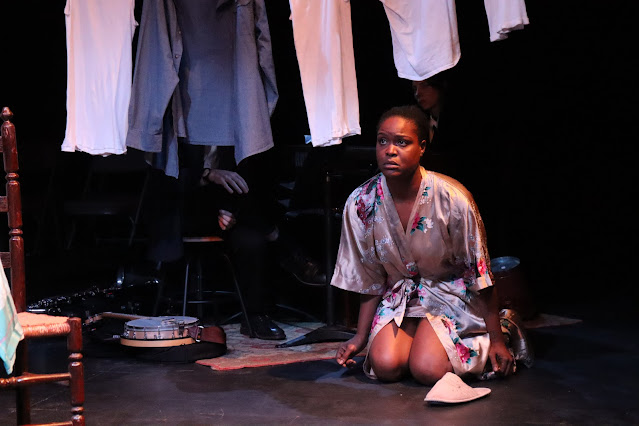We Do the Same Thing Every Week
Written by Robert Leverett
Directed by Liza Couser
502 W 53rd St., Manhattan, NYC
May 2-17, 2025
 |
| Kate Budney, Jessica Nesi, Justin Choi, Robert Leverett. Photo by HanJie Chow. |
How often, as we move through adult life, can we say that we encounter genuinely new and interesting experiences? And if something that meets (or seemed to meet) those criteria did happen–perhaps, say, one was visited by a magical man-sized anthropomorphic cat–how many repetitions would it take before that too felt mundane? Robert Leverett's play
We Do the Same Thing Every Week might make audiences question whether that number would even reach one.
We Do the Same Thing Every Week mixes inspiration from Dr. Seuss and existentialism and adds a dash of physics and a soupçon of the cosmic horror of existence for a dark, delightful absurdist comedy capacious enough to encompass both the boredom of a rainy afternoon and the death of the universe as we know it.
 |
| Casey Worthington. Photo by HanJie Chow. |
When the play begins, Dick (playwright Leverett) and Jane (Jessica Nesi), dressed in clothing evocative of 1950s America–a pastel pink sweater with short pants for him, a pastel blue dress with a headband for her–and with both their parents (with whom, they explain, they live as adults) out of the house, are passing the tedium of a rainy Sunday with gin rummy and tea, an abandoned book of crosswords on the table to Dick's right. Their home sports the bold solid colors and crooked doorways of Seussian art (though the effect of the whole might also bring to mind a Tim Burton suburbia); and indeed, when Jane wishes (with the air of someone who knows what the wish will entail) for an ice-cold Coca-Cola, the delivery man who materializes is not a man but a tall, humanoid cat (Casey Worthington) who, though lacking a hat, certainly resembles in his promises of fun a character from a certain well-known children's book. The Cat, like the character he recalls, enlists the help of two "Things"–Thing A and Thing B, a pair of spiky-headed puppets performed by Kate Budney and Justin Choi, respectively–whom he stresses are to be regarded as such and not as people. (Given the Things' status as, basically, exploited workers in the Cat's entertainment business, one might go so far as to discern in their designation as things a slight echo of the repeated weekly “thing” of the play’s title.) But before the arrival of the Things, Dick and Jane insist on laying out some demands regarding what sort of fun they do not want. In
The Cat in the Hat (1957), the children and their pet fish seem rather resistant to the anarchic–but ultimately completely contained–antics of the titular cat, but Dick and Jane’s affect extends far beyond the rules-boundedness of their Seussian counterparts to a deep-rooted ennui. And as part of an attempt to counter that existential boredom and to feel some investment in the proffered distractions, the pair desire the threat of consequences if they fail to have fun. The Cat's agreement to this stipulation may itself be quite consequential indeed; and the sitcom-style entrance of Dick and Jane's Fish (Tora Nogami Alexander), described by both as "annoying," after what the Cat feels is a subpar musical number by the Things bodes less well for the potential for Dick and Jane to have fun than it does for the audience.
 |
| Jessica Nesi, Justin Choi, Kate Budney. Photo by HanJie Chow. |
As the Cat and his companions try to get Dick and Jane to feel interest rather than generalized anxiety, the play prompts us to consider the shrinking distance between the experiential moment and our awareness of its instant, irrevocable pastness–as opposed to the surprisingly large distance between not only interesting experience but also between all particles in the universe. The Coca-Cola branding that has rooted itself as deeply in Dick's and Jane's consciousness as their ennui plays to an individual's nostalgia for a time before that awareness, not unlike a huge swath of our current media culture, promising to recapture an ever-receding time of pleasurably unmediated experience. Enmeshed with these ideas, reset and repetition are built into the narrative on the scales of both Dick and Jane and of the cosmos–if there is, in the end, any distinction between the two.
 |
| Jessica Nesi, Tora Nogami Alexander, Robert Leverett. Photo by HanJie Chow. |
Leverett and Nesi's deadpan Dick and Jane make for an excellent comic pairing with Worthington's beleaguered but obstinately cheerful Cat and Budney and Choi's frustrated Things, with Nogami Alexander's Fish a hilariously big, brash contrast to Leverett and Nesi's largely more buttoned-down performances (Nesi's silent reactions are often, it deserves mentioning, very funny on their own). Grace Oberhofer's sound design often provides aural effects for mimed actions–the slurping of soda from an empty Coke bottle, for instance–lending a hint of the off-kilter when it is not helping to embody the awesome power of the universal void. The play's magnificent climax, which centers what one might describe as a grandly cosmic riff on a
Peanuts adult, is not only aurally and visually striking but makes masterful use of projected dialogue that is revised as we watch.
We Do the Same Thing Every Week may not cure the existential malaise of waiting through life, but it sure offers a superb distraction in the meantime.
-John R. Ziegler and Leah Richards







Comments
Post a Comment